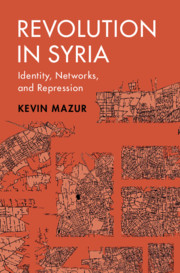Book contents
- Revolution in Syria
- Cambridge Studies in Comparative Politics
- Revolution in Syria
- Copyright page
- Dedication
- Contents
- Figures
- Tables
- Acknowledgments
- A Note on Transliteration
- 1 Introduction
- 2 Theory
- 3 Networks, Identities, and Patronage in Contemporary Syria
- 4 Events of the Syrian Uprising
- 5 Initial Forms of Challenge
- 6 State Networks and Nonparticipation
- 7 Logics of State Repression and Societal Response
- 8 Particularizing Challenge in Kurdish Areas
- 9 Conclusion
- Appendix
- Chronology of Major Events in the First Year of the 2011 Syrian Uprising
- References
- Index
- Series page
1 - Introduction
Published online by Cambridge University Press: 18 June 2021
- Revolution in Syria
- Cambridge Studies in Comparative Politics
- Revolution in Syria
- Copyright page
- Dedication
- Contents
- Figures
- Tables
- Acknowledgments
- A Note on Transliteration
- 1 Introduction
- 2 Theory
- 3 Networks, Identities, and Patronage in Contemporary Syria
- 4 Events of the Syrian Uprising
- 5 Initial Forms of Challenge
- 6 State Networks and Nonparticipation
- 7 Logics of State Repression and Societal Response
- 8 Particularizing Challenge in Kurdish Areas
- 9 Conclusion
- Appendix
- Chronology of Major Events in the First Year of the 2011 Syrian Uprising
- References
- Index
- Series page
Summary
This chapter presents the book’s research question, central argument, and structure. It begins with an empirical puzzle that challenges the conventional wisdom of how violent conflict on ethnic lines breaks out. Residents of the Syrian city of Dayr al-Zur fit the profile of an “ethnically excluded” population – Sunni Arabs who get few public goods from the state – but they did not rise up uniformly against the regime. Rather, a patchwork of linkages between the state and local leaders made mobilization uneven and generated state–society negotiation across the Sunni–ʿAlawi ethnic boundary. This puzzle motivates the book’s broader question: what “ethnicizes” revolutionary situations faced by ethnically dominated regimes? The chapter then characterizes the diverse forms of contention found in the Syrian uprising and demonstrates that initial contestation was primarily focused at the sub- and supra-ethnic levels, only later coming to revolve around ethnic claims. It then previews the mechanisms pushing challenger–incumbent interaction toward ethnic violence and discusses the research design and methods employed in the book.
- Type
- Chapter
- Information
- Revolution in SyriaIdentity, Networks, and Repression, pp. 1 - 22Publisher: Cambridge University PressPrint publication year: 2021



